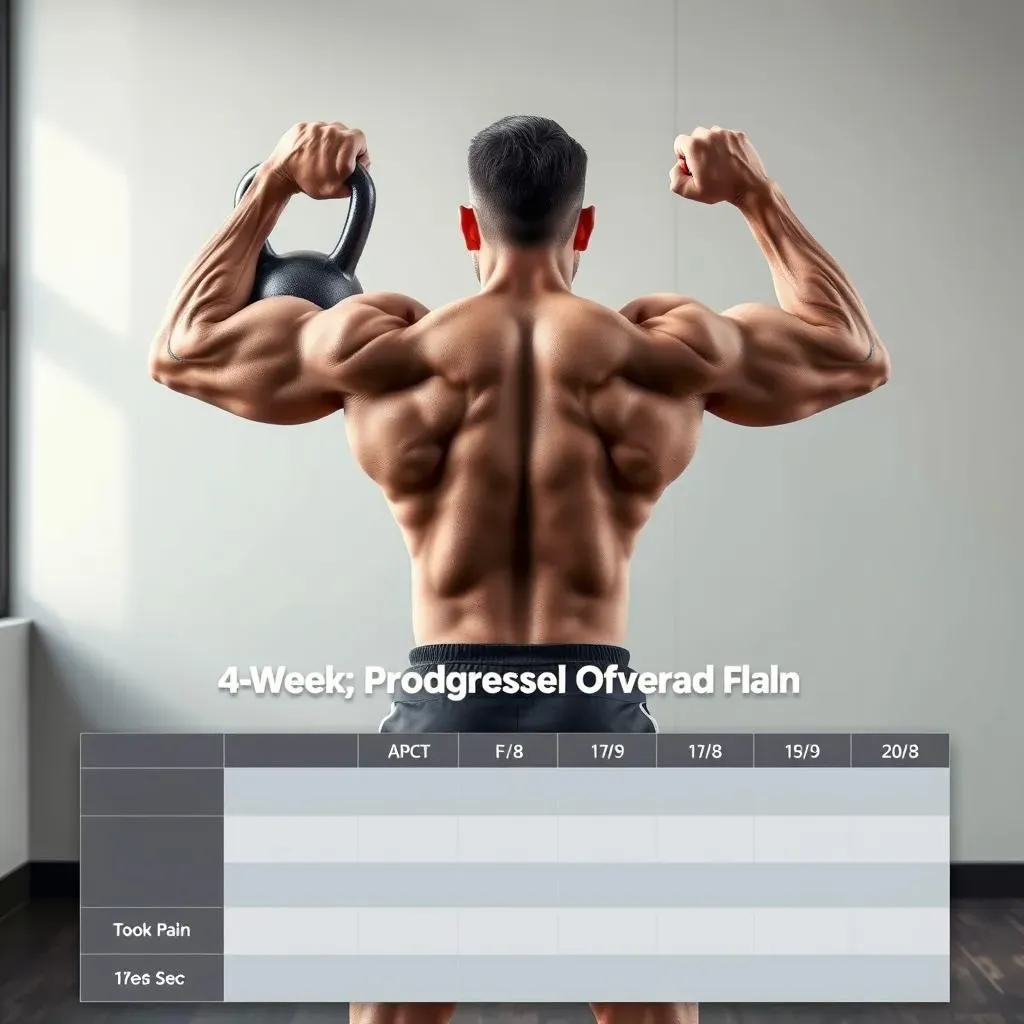Table of Contents
Ready to forge a back of steel using just a kettlebell? Forget boring gym machines; we’re diving into the world of dynamic, effective kettlebell exercises back that will not only build muscle but also boost your overall strength and posture. I get it, you might be thinking, "kettlebells are just for swings," but trust me, there's a whole universe of back-building potential waiting to be unlocked. This article isn’t just another list of moves; it’s your guide to understanding how these exercises work, why they're beneficial, and how to integrate them into a killer routine. We’ll explore the key muscles involved, the unique advantages of kettlebell training for your back, and of course, the top 10 exercises that will get you there. Plus, we’ve crafted a sample 4-week workout plan to get you started. So, ditch the excuses and let's get to work, your stronger, more resilient back is waiting.
Understanding Your Back Muscles for Effective Kettlebell Training

Understanding Your Back Muscles for Effective Kettlebell Training
The Mighty Latissimus Dorsi
Okay, so you want a strong back? Let's talk lats, or the latissimus dorsi, to be precise. These are the big, wing-like muscles that run down the sides of your back. They're not just for show; they're powerhouses when it comes to pulling movements. Think of them like the engine that drives your rows, pullovers, and even helps with those swings. When you're doing kettlebell exercises back, you're constantly engaging the lats, which is why they're so crucial to understand. They help you pull the weight close to your body, control the movement, and generate force. They also play a key role in shoulder stability, which is vital when you're slinging iron around.
Ignoring your lats is like building a house without a foundation, it's just not going to work well. I remember when I first started, I focused only on my biceps, thinking that was the key to a strong upper body. Boy, was I wrong! It wasn't until I started really focusing on my lats that my pull-ups improved, my rows got stronger, and my back started to look more like a mountain range than a speed bump. So, pay attention to those lats; they’re the unsung heroes of back day.
The Core and Spinal Erectors
Now, let’s not forget the unsung heroes of the spine: the spinal erectors. These muscles run along your spine, keeping you upright and stable. They are like the support beams of your back, and they’re constantly working, whether you’re lifting a kettlebell or just sitting at your desk. When you do deadlifts or single-leg RDLs with a kettlebell, your spinal erectors are working hard to keep your back from rounding and protect your spine. If you want to do kettlebell exercises back safely and effectively, you need to pay attention to them.
And then there’s your core. Yes, it's not technically a back muscle, but it's your back's best friend. A strong core acts like a natural weight belt, stabilizing your spine and preventing injuries. Think of your core and spinal erectors as the dynamic duo that protects your back during any kettlebell exercises back. They work together to create a stable platform from which you can generate power. If your core is weak, your back will compensate, leading to potential pain and injury. So, before you jump into those heavy lifts, make sure your core is ready for the challenge.
Muscle Group | Function | Key Kettlebell Exercises |
|---|---|---|
Latissimus Dorsi | Pulling, shoulder stability | Rows, Pullovers, Swings |
Spinal Erectors | Spinal stability, posture | Deadlifts, Single-Leg RDLs |
Core Muscles | Spinal stabilization, power transfer | All exercises (when engaged properly) |
Why Kettlebells Are Awesome for Back Strength: Benefits and Advantages

Why Kettlebells Are Awesome for Back Strength: Benefits and Advantages
Beyond the Basics: The Kettlebell Advantage
So, why should you ditch the dumbbells and barbells for kettlebells when it comes to back training? Well, for starters, kettlebells aren't just weights; they're tools for dynamic movement. Unlike traditional weights, the offset center of gravity in a kettlebell forces you to engage your core and back muscles in a different way. This means you're not just lifting weight; you're also fighting to control it, which leads to greater muscle activation and improved stability. Think of it like this: a dumbbell is like carrying a suitcase, while a kettlebell is like carrying a bucket of water, you have to work harder to keep it steady. This constant stabilization is what makes kettlebell exercises back so effective.
Also, kettlebells are incredibly versatile. You can go from swings to rows to deadlifts without switching equipment. This means you can create a full-body workout that targets your back from multiple angles. I remember the first time I tried a kettlebell clean; it felt like my entire back was working in unison. It's not just about lifting heavy; it's about moving well. Kettlebell exercises back also promote better movement patterns, which translate to better performance in everyday life. Plus, they're just plain fun to use. There's something about swinging a kettlebell that makes you feel like a total badass.
Real-World Benefits: More Than Just Muscle
The benefits of kettlebell exercises back extend far beyond just building muscle. First off, they're fantastic for improving your posture. Many of us spend our days hunched over desks, which can lead to weak back muscles and poor posture. Kettlebell exercises like rows and deadlifts help strengthen the muscles that pull your shoulders back and keep your spine in alignment. I've personally noticed a huge difference in my posture since incorporating kettlebells into my routine. I no longer feel like a question mark when I'm standing up straight. Also, they can help reduce your risk of injury. A strong back is a resilient back. When your back muscles are strong and stable, they're better able to handle the stresses of everyday life, whether that's lifting heavy groceries or playing with your kids.
And let's not forget about functional strength. Kettlebell exercises mimic real-world movements, which means the strength you gain in the gym translates to strength in your daily life. Think of picking up a heavy box or carrying a bag of groceries. These are the types of movements that kettlebell exercises back prepare you for. It's not just about looking good; it's about being strong and capable in everything you do. I've found that since I started using kettlebells, I'm not as easily fatigued during these daily tasks. It's like having a secret superpower, but it's really just a strong back.
Benefit | Description | Real-World Impact |
|---|---|---|
Dynamic Movement | Kettlebells engage more muscles due to their offset center of gravity | Improved muscle activation and stability |
Versatility | Multiple exercises with one tool | Full-body workouts and time-efficient training |
Posture Improvement | Strengthens back muscles to align the spine | Reduced back pain and better overall posture |
Injury Prevention | Builds a resilient back that is less prone to injury | Safer and more confident movement |
Functional Strength | Mimics real-world movements | Strength that translates to daily tasks |
10 Best Kettlebell Exercises for a Powerful Back

10 Best Kettlebell Exercises for a Powerful Back
Single-Arm Kettlebell Rows: The Back Builder
Alright, let's get into the nitty-gritty. First up, we have the single-arm kettlebell row. This isn't your average row; it's a powerhouse for your lats and upper back. You'll be in a bent-over position, one hand on a bench or stable surface, and the other holding the kettlebell. As you pull the weight towards your chest, make sure to keep your core engaged and your back straight. This prevents any unwanted spinal twists and ensures you're hitting the right muscles. Think of it as pulling your elbow towards the ceiling, not just lifting the weight. I like to imagine I'm starting a lawnmower, but instead of a loud engine, I'm building back muscles.
What’s great about this move is that it’s not just about pulling; it’s about control. You're fighting against the weight, which is great for developing those stabilizing muscles around your shoulder blades. I remember when I first started, I was all over the place, but as I got better at controlling the weight, I felt a huge difference in my back strength. It's all about that mind-muscle connection, feeling the muscles work as you pull. Make sure you're doing both sides evenly to avoid any imbalances. This is a non-negotiable in any kettlebell exercises back routine, if you ask me.
Kettlebell Deadlifts: The King of Back Exercises
Next up, we have the king of all back exercises, the kettlebell deadlift. Now, I know what you might be thinking: "deadlifts are scary." But with a kettlebell, they're actually quite approachable and incredibly effective. The key here is to focus on keeping your back straight and hinge at your hips, not your lower back. Imagine you're trying to close a car door with your butt, that’s the movement you're going for. As you lift the kettlebell from the floor, drive through your heels, and squeeze your glutes at the top. This move targets your entire posterior chain, from your lower back to your hamstrings. It's the one exercise that makes you feel like you've actually accomplished something.
This isn't just about lifting the weight; it's about controlling the movement and maintaining proper form. I see so many people rounding their backs during deadlifts, and that's a recipe for disaster. So, start light, focus on your form, and work your way up. The kettlebell deadlift not only strengthens your back but also improves your grip strength and core stability. It’s a full-body movement that builds a foundation for all other exercises. Incorporating this into your routine is a must for anyone serious about kettlebell exercises back.
Exercise | Primary Muscles Targeted | Why it's Effective |
|---|---|---|
Single-Arm Kettlebell Rows | Latissimus Dorsi, Rhomboids | Develops pulling strength and shoulder stability |
Kettlebell Deadlifts | Spinal Erectors, Glutes, Hamstrings | Builds overall back strength and power |
Sample Kettlebell Back Workout Routine: A 4Week Plan

Sample Kettlebell Back Workout Routine: A 4Week Plan
Getting Started: The 4-Week Framework
Okay, so you're ready to put all this knowledge into action? Awesome! This 4-week plan is designed to progressively challenge your back muscles, so you're not just going through the motions. We're going to start with a solid foundation and gradually increase the intensity, so you're seeing real results. Think of it like building a pyramid; you need a strong base to reach the top. This plan includes a variety of kettlebell exercises back, hitting your muscles from different angles. Each week, we'll focus on either increasing the weight, the reps, or the sets, that's what we call progressive overload. It's like giving your muscles a little nudge every week, so they keep adapting and getting stronger. Remember, consistency is key! This isn't a sprint, it's a marathon, so stick with the plan and you'll be amazed at what you can achieve.
Before we jump in, a quick note: make sure you've got the basics down. If you're new to kettlebells, start with lighter weights and focus on perfecting your form. It’s better to do fewer reps with good form than a bunch with bad form. Also, listen to your body. If something feels off, don't push through the pain. Take a break, adjust, and come back stronger. This isn't about pushing yourself to the point of injury, it's about building a sustainable routine that you can stick with long term. Now, let's dive into the plan!
The Weekly Breakdown: What to Expect
Each week in this 4-week plan has a specific focus. Week 1 is all about building a base, getting comfortable with the movements, and making sure your form is on point. We’ll be using lighter weights and focusing on higher reps to get your muscles ready for the challenge ahead. Week 2, we start to add a little more weight and reduce the reps slightly, this is where things start to get a little tougher. Week 3, we crank up the intensity with heavier weights and fewer reps, pushing your muscles to their limits. Finally, week 4 is all about testing your progress and preparing for the next phase of your training. It's like you're climbing a staircase, each step getting you closer to your goal of a stronger back. Remember, rest and recovery are just as important as the workouts. Make sure you're getting enough sleep and fuel your body with the right nutrition to maximize your results. This isn't just about working hard, it's about working smart.
Now, let's talk about the exercises. We'll be using a mix of kettlebell deadlifts, single-arm rows, back extensions, cleans, pullovers, and chest-supported rows throughout the plan. These exercises are chosen because they target all the major muscles in your back and provide a well-rounded approach to back training. We'll also be focusing on proper engagement of your core muscles to ensure you're getting the most out of each exercise and protecting your spine. I've seen so many people neglect their core, and it's a recipe for disaster. It’s like building a car with a weak chassis; everything else falls apart. So, make sure you're bracing your core during each movement. Think of it like you're about to get punched in the stomach, that's the level of engagement you should be aiming for. Now, let's look at the weekly schedule.
Week | Focus | Intensity |
|---|---|---|
Week 1 | Foundation | Lighter weight, higher reps |
Week 2 | Increased Load | Moderate weight, moderate reps |
Week 3 | Peak Strength | Heavier weight, lower reps |
Week 4 | Testing and Recovery | Moderate weight, moderate reps |
The Sample Schedule: A Week-by-Week Guide
Alright, let's break down what a typical week looks like. We'll be working out three times a week, with rest days in between to allow your muscles to recover. For example, you can do Monday, Wednesday, and Friday, or Tuesday, Thursday, and Saturday. It's up to you, but make sure you're consistent. Each workout will include a warm-up, the main exercises, and a cool-down. The warm-up should consist of some light cardio and dynamic stretches to get your muscles ready for work. The cool-down should include static stretches to improve flexibility and promote recovery. Now, let's talk exercises. Week 1, we'll focus on 3 sets of 12-15 reps for each exercise. Week 2, we’ll increase the weight and do 3 sets of 10-12 reps. Week 3, we go heavy with 3 sets of 6-8 reps. And finally, week 4, we’ll go for 3 sets of 10-12 reps again, focusing on good form and control.
Remember, the goal isn't just to get through the workout; it's to do each exercise with intention. Think about the muscles you're working and focus on engaging them throughout the movement. It’s like you're having a conversation with your muscles, making sure they're doing their job. Also, don’t be afraid to adjust the weights or reps based on your own fitness level. This plan is a guide, not a rigid rulebook. The most important thing is that you're challenging yourself without compromising your form. So, are you ready to get started? I know I am! Let’s build a stronger back together, one kettlebell exercise at a time.
Wrapping Up: Your Journey to a Stronger Back with Kettlebells
So, there you have it – a comprehensive guide to transforming your back with kettlebell exercises. We've covered the essential anatomy, the unique benefits of kettlebell training, ten killer exercises, and a sample workout plan to get you started. Now, it's up to you to put in the work. Remember, consistency is key, so don't get discouraged if you don't see results immediately. Keep pushing, keep learning, and most importantly, keep swinging those kettlebells. Your back will thank you for it, and you'll be amazed at the strength and resilience you can build. Now go forth, and build a back that's not just strong, but also impressive.